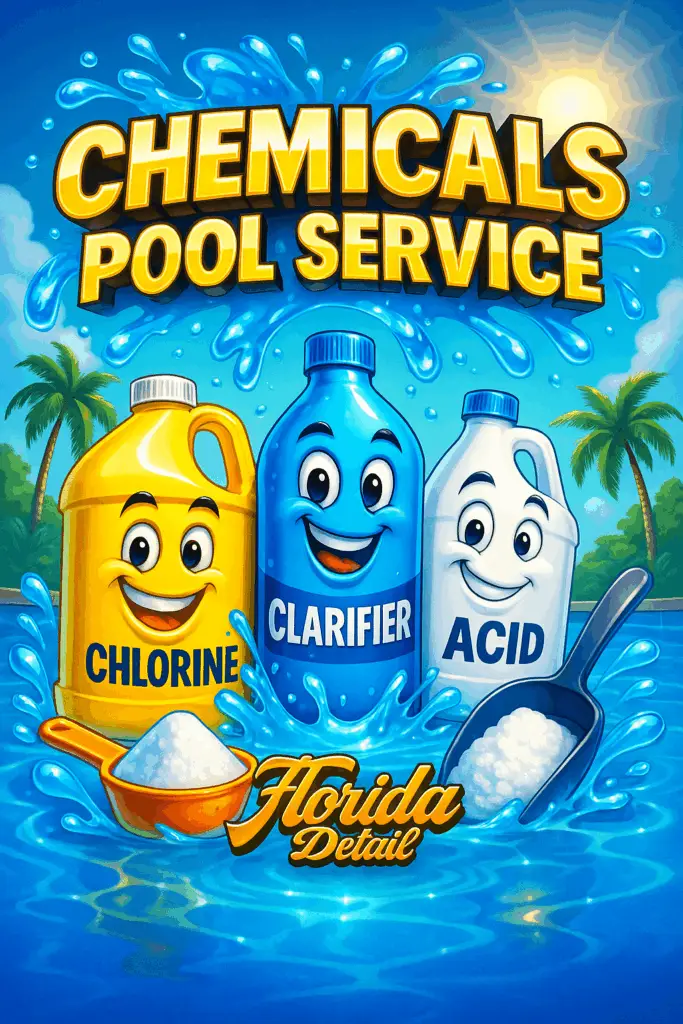🌞 How to Balance Pool Chemicals Safely During Summer Months
Introduction
Summer in Charlotte County — whether you live in North Port, Port Charlotte, Punta Gorda, or Rotonda — means more pool parties, longer swim days, and yes, extra maintenance. With higher water temperatures, stronger UV rays, and sudden summer storms, your pool’s chemical balance can shift quickly.
At Florida Detail, we know that properly balanced pool water is the key to keeping it clear, safe, and comfortable. In this guide, we’ll walk you through safe summer pool chemical balancing tips so your water stays sparkling all season long.
🌊 Why Pool Chemistry Matters More in Summer
- Heat speeds up chlorine loss through UV breakdown.
- Rainwater dilutes chemicals, lowering chlorine and pH.
- More swimmers = more contaminants like sweat, sunscreen, and oils.
- High temps encourage algae growth if balance slips.
💡 Local note: After a typical Florida thunderstorm, algae can begin forming in as little as 24–48 hours if water isn’t treated properly.
✅ Step-by-Step: Balancing Pool Chemicals in Summer
1. Test Water More Frequently
- Test at least 2–3 times per week in the summer.
- Use a reliable test kit (digital testers give more accuracy than strips).
2. Maintain Chlorine Levels
- Ideal range: 1–3 ppm.
- Shock the pool weekly or after heavy rain/swimming parties.
- Consider stabilized chlorine to slow UV breakdown.
3. Balance pH Levels
- Ideal range: 7.2–7.6.
- If pH is low: Add soda ash.
- If pH is high: Add muriatic acid in small amounts.
⚠️ Always add acid to water, never water to acid.
4. Adjust Total Alkalinity
- Ideal range: 80–120 ppm.
- Helps stabilize pH.
- Raise alkalinity with baking soda, lower with acid.

5. Monitor Calcium Hardness
- Ideal range: 200–400 ppm.
- Prevents scale and corrosion.
- In areas like Punta Gorda, where water can be hard, keep an eye on deposits.
6. Use Cyanuric Acid (CYA) for Sun Protection
- Ideal range: 30–50 ppm.
- Protects chlorine from being destroyed by sunlight.
- Avoid exceeding 70 ppm, or chlorine effectiveness drops.
7. Improve Circulation and Filtration
- Run pump 8–10 hours daily in hot weather.
- Backwash or clean filters weekly.
- Brush walls, steps, and corners to prevent algae spots.
8. Shock After Storms and Parties
- Use chlorine shock or a non-chlorine oxidizer.
- Shocking clears organic waste, sunscreen oils, and bacteria.
🌟 Safety Tips for Handling Chemicals in Summer
- Store chemicals in a cool, shaded, dry space.
- Wear gloves and protective eyewear when handling acids and chlorine.
- Add chemicals one at a time — never mix.
- Keep chemicals away from kids and pets.
📋 Quick Summer Balancing Checklist
- ✅ Test water 2–3 times per week
- ✅ Keep chlorine at 1–3 ppm
- ✅ Balance pH between 7.2–7.6
- ✅ Adjust alkalinity to 80–120 ppm
- ✅ Check calcium hardness and CYA monthly
- ✅ Run pump 8–10 hours daily
- ✅ Shock weekly or after storms
📌 Internal & External Links
- Explore our Services
- Contact Florida Detail for professional summer care
- Related Blog: Step-by-Step Guide to Balancing Pool Chemicals Safely
- SEO Resource: UnlimitedManiac.com
- Local backlinks: PoolServiceInPortCharlotte.com, NorthPortPoolServices.com
❓ FAQs About Summer Pool Chemical Balancing
Q1: Why does my chlorine disappear faster in summer?
The sun’s UV rays break it down faster, especially without stabilizer (CYA).
Q2: Should I shock my pool weekly in summer?
Yes — weekly shocking is strongly recommended during Florida’s hot months.
Q3: How soon can I swim after shocking?
Wait until chlorine levels drop to 1–3 ppm, usually 12–24 hours.
Q4: Is it safe to add chemicals during the day?
For best results, add chlorine in the evening to prevent UV loss.
🏝️ Conclusion
Balancing pool chemicals during Florida summers doesn’t have to be stressful. By testing more often, keeping chlorine stabilized, and following these safe handling tips, you can enjoy crystal-clear water all season in Port Charlotte, Punta Gorda, North Port, Rotonda, and across Charlotte County.
Want a stress-free pool care routine? Let Florida Detail handle your weekly service so you can relax and enjoy your backyard oasis without worrying about water chemistry.
